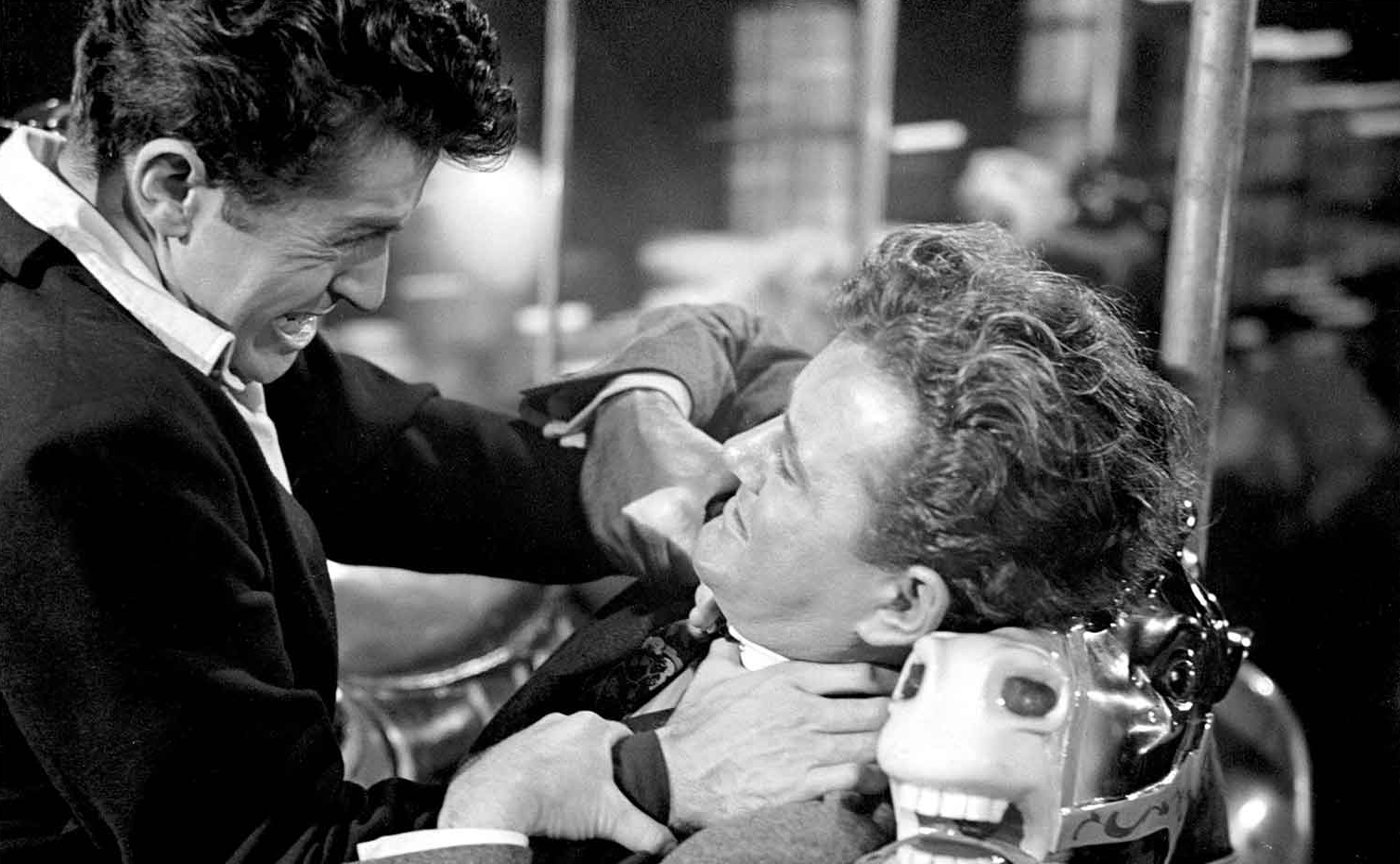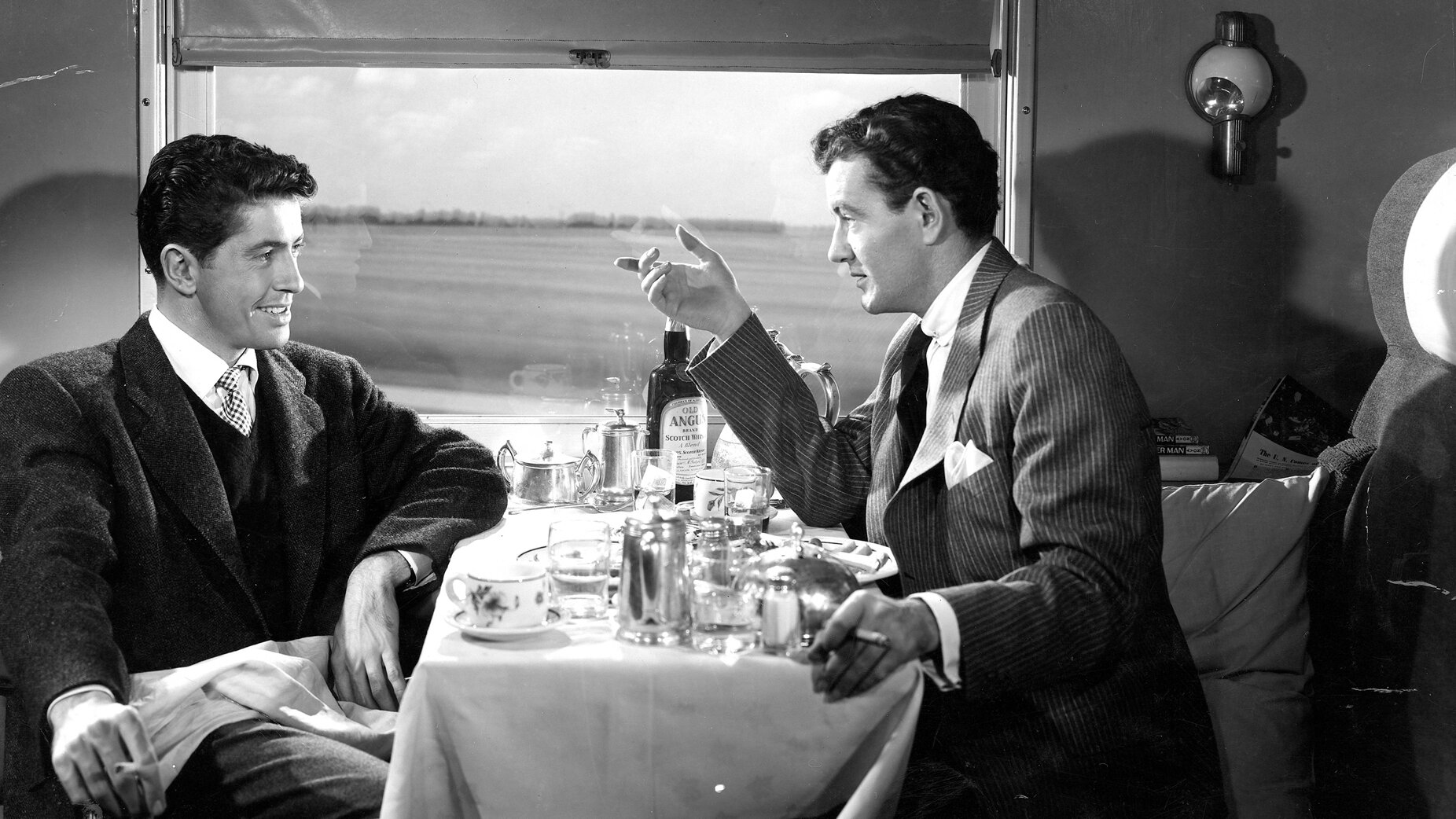Review: Strangers on a Train
Inspired by Patricia Highsmith's novel of the same name, Alfred Hitchcock's Strangers on a Train (1951) is a near perfect film based on the idea of how one could execute a perfect murder. Tennis star Guy Haines (Farley Granger) is recognized by Bruno Anthony (Robert Walker) on a train and the two begin an intimate conversation. Bruno learns that Guy wishes to divorce his cheating wife Miriam (Laura Elliott) to marry Anne Morton (Ruth Roman). The eccentric Bruno suggests a plan for a flawless crime: he could kill Miriam and Guy could kill Bruno's father. The problem with this perfect plan is that only Bruno follows through with what was simply a far-flung, hypothetical idea to Guy.
The proliferation of doubles in Strangers on a Train is one the movie's most exciting and defining elements. Like the X's strewn throughout Martin Scorsese's The Departed to hint at the imminent death of a character, the various mentions of doubles or crisscrosses, verbally as Bruno is prone to say ("The only kind of doubles I play" while ordering whiskey) and visually with the crossed tennis racquets on the infamous lighter, Hitchcock carrying a double bass in his cameo, and switching train tracks (which symbolizes the undeniably new direction the characters' lives take after their encounter) are marked characteristics of Strangers on a Train. Hitchcock also conveys the themes through his editing techniques of cutting back and forth between the two men's lives, which reflects Highsmith's practice of bouncing between the perspectives of Guy and Bruno in her novel. Right from the start of the film, we follow the two men who are clearly distinguished by their divergent choices in shoe wear, as Bruno wears an ostentatious black and white pair while Guy's are plain black. This marks the beginning of us seeing them concurrently as doubles and opposites, a complex feat Hitchcock is able to accomplish in stride.
The idea of opposites also manifests itself in the film with the emphasis placed on dark versus light. Bruno, as the film's antagonist, is meant to embody darkness, which is exhibited when he is the lone dark figure standing on the stark white Jefferson Memorial. This also symbolizes the way in which Bruno is not symbiotic with the law and order epitomized by the government. Bruno comes to represent the looming shadow that follows Guy everywhere. When Bruno steps out of the shadows, he causes problems for himself and others, such as when he deigns to step into the light while in line for the tunnel of love and is immediately spotted by the worker who recognized him from the night of the murder. Further, Bruno calls out to Guy from the shadows while lurking outside of his townhouse to tell him he murdered Miriam, which turns our heroes' world on its side. This is mirrored by the slanted angle of the shot. Foreshadowing is another element utilized throughout the film such as when Bruno says to Guy upon meeting him, I certainly admire people who do things, and later takes matters into his own hands.
Alfred Hitchcock's nickname, The Master of Suspense, is completely justified by his directorial choices in Strangers on a Train. The film is an amalgamation of scenes, techniques, and performances that get your heart racing without relying on the common souped-up tropes of the thriller. For example, one of the most exciting episodes in the film occurs when Bruno follows Miriam to the carnival and executes her murder. The seemingly unfitting setting of the carnival adds a disturbing quality to the happenings. The moment when Bruno stops to buy popcorn with the joyous Ain't She Sweet playing in the background also adds to the scene's unsettling nature. The dramatic irony is palpable when we see Bruno staring at Miriam and her giving him flirtatious glances back, as she most likely sees him as an enamored potential suitor. The film cuts back and forth between mostly empty, dark, zoomed out shots of the stiff Bruno staring at Miriam to close-up, full, bright views of her peeking at him coyly and eating ice cream. The contrast helps to highlight the impending doom we feel for Miriam, which is further experienced when they go through the tunnel of love. We see the shadows of the characters, Bruno gaining on Miriam's boat and hear her let out a scream while we get a shot of the outside of the ride, then feel relief when we see that it was a shriek of joy. The spinning of wheels (ferris, water and car) in the background of most of the shots helps to add momentum to the scene. Finally, the murder of Miriam as shot through the reflection of her glasses was a technical feat of immense effort. It creatively shows her death as almost beautiful, which to Bruno it would be, as he thought it would mark the beginning of the end to his troubles.
The heart of Strangers on a Train is found in Guy. Like many of Hitchcock's other films, the pulse of Strangers on a Train revolves around the wrongly accused having to prove themselves innocent. The Wrong Man, North by Northwest, The 39 Steps and many more of Hitchcock's narratives are driven around mistaken identity, as the director's greatest fear was being incorrectly fingered for a crime. We wouldn't feel too strongly about the actions of the crazy Bruno and his killing of a decidedly ruthless, unfaithful woman if his actions didn't have direct implications for the fate of Guy. As his name suggests, Guy is an affable everyman who finds himself in an extreme situation. Time and time again, his sympathetic nature is exhibited in the way he treats Anne's sister Barbara (Patricia Hitchcock) and the police officers, shrugs off Bruno's increasingly alarming ramblings on the train, and saves the little boy from flying off the carousel even when his own life is in peril. Guy and Bruno act as each other's doppelgangers, specifically in the sense that Bruno is Guy's evil twin. Bruno wants he and Guy to put themselves in each other's shoes, to do each other a favor by committing the other's crime, but as we see in the film's opening, Bruno's shoes are not a fit for Guy.
The original version of the film ended after Bruno's death when his unfurled hand reveals the lighter, but in the US version, Guy is reunited with Anne on a train back home. A clergyman sitting across from them asks if he is Guy Haines and the couple quickly leaves. The ending points to a future wedding for the pair (because of the clergyman's presence) and shows that they have made it through this trauma with their relationship intact. However, I find that Bruno's death, Guy's ironic declaration that he was a very clever fellow, and him walking away from the scene of the crime to be a more hauntingly apt ending.

